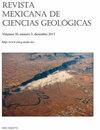Spherical data validation of rock discontinuities orientation from Drone-derived 3D Point Clouds
IF 0.5
4区 地球科学
Q4 GEOSCIENCES, MULTIDISCIPLINARY
Revista Mexicana De Ciencias Geologicas
Pub Date : 2021-11-24
DOI:10.22201/cgeo.20072902e.2021.3.1641
引用次数: 0
Abstract
This work presents a methodology for the statistical validation of discontinuity surfaces obtained from point clouds using digital photogrammetry from drones. Our methodology allows you to review the quality of the data obtained with photogrammetry and decide whether these measurements are representative of the discontinuity surfaces that they analyze. It consists of three steps, the first one being a shape analysis that allows defining which statistical model should be used: Fisher for circularly symmetric clusters or Bingham fits better for axially symmetric clusters. This step also makes the most significant difference to other works since our methodology starts from the premise that not all discontinuity surfaces are flat. Therefore, Fisher parameters do not allow validating data that do not correspond to a plane. In the second step of the methodology, we calculate the consistency parameters that depend on the statistical model defined in step 1. The parameters are similar for both models; both estimate κ which indicates how much the sample is concentrated around the mean orientation and validates the existence of this and which is the value of the generating angle of a cone with a 95 % confidence limit that it contains within the mean orientation. Finally, step 3 is used when there are control measurements to compare the point cloud data and define if both samples characterize the same discontinuity surface in the rock mass. The results obtained on a rock outcrop allowed us to observe that the measurements obtained from the drone faithfully represent the discontinuity surface analyzed when these were compared with the measurements made manually with the compass. Furthermore, the dispersion parameters (无人机三维点云岩石不连续性方位的球形数据验证
这项工作提出了一种使用无人机数字摄影测量从点云获得的不连续表面的统计验证方法。我们的方法允许您审查通过摄影测量获得的数据的质量,并决定这些测量是否代表他们分析的不连续表面。它由三个步骤组成,第一步是形状分析,允许定义应该使用哪种统计模型:Fisher更适合圆对称集群,而Bingham更适合轴对称集群。这一步也是与其他作品最显著的不同之处,因为我们的方法是从并非所有不连续表面都是平坦的前提开始的。因此,Fisher参数不允许验证不对应于平面的数据。在该方法的第二步中,我们计算依赖于步骤1中定义的统计模型的一致性参数。两个模型的参数相似;两者都估计κ,它表示样本集中在平均方向周围的程度,并验证了它的存在性,这是一个锥体的生成角的值,具有95%的置信限,它包含在平均方向内。最后,当有控制测量来比较点云数据并确定两个样本是否表征岩体中相同的不连续面时,使用步骤3。在岩石露头上获得的结果使我们能够观察到,从无人机获得的测量值忠实地代表了分析的不连续表面,当这些测量值与用指南针手动测量值进行比较时。此外,色散参数(
本文章由计算机程序翻译,如有差异,请以英文原文为准。
求助全文
约1分钟内获得全文
求助全文
来源期刊

Revista Mexicana De Ciencias Geologicas
地学-地球科学综合
CiteScore
1.00
自引率
12.50%
发文量
0
审稿时长
6-12 weeks
期刊介绍:
Revista Mexicana de Ciencias Geológicas (RMCG) publishes original research papers on geological processes of broad interest, and particularly those dealing with regions of Latin America. The RMCG also publishes review papers on topics of current interest, and on the geology and tectonics of geological provinces of Latin America. Besides, it offers the opportunity for host editors to publish special thematic issues.
 求助内容:
求助内容: 应助结果提醒方式:
应助结果提醒方式:


